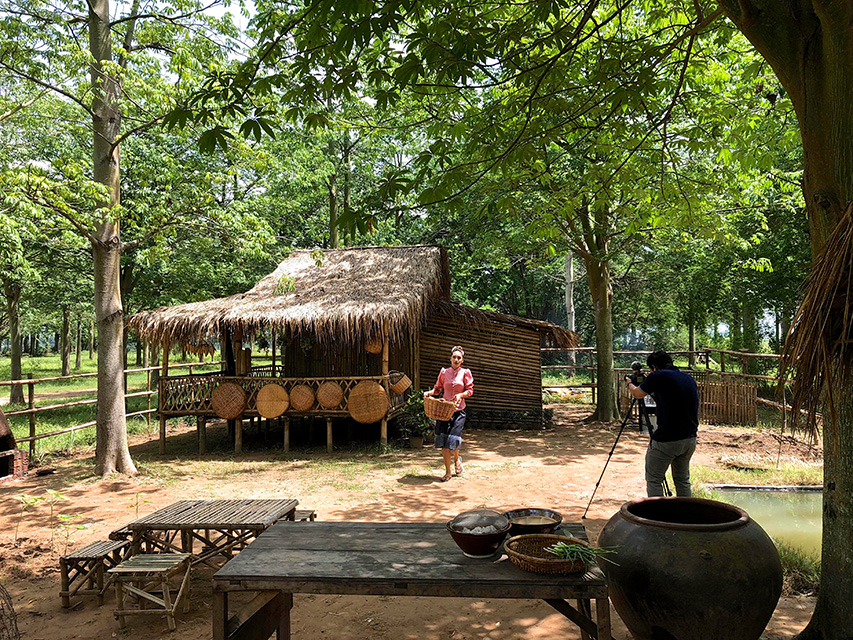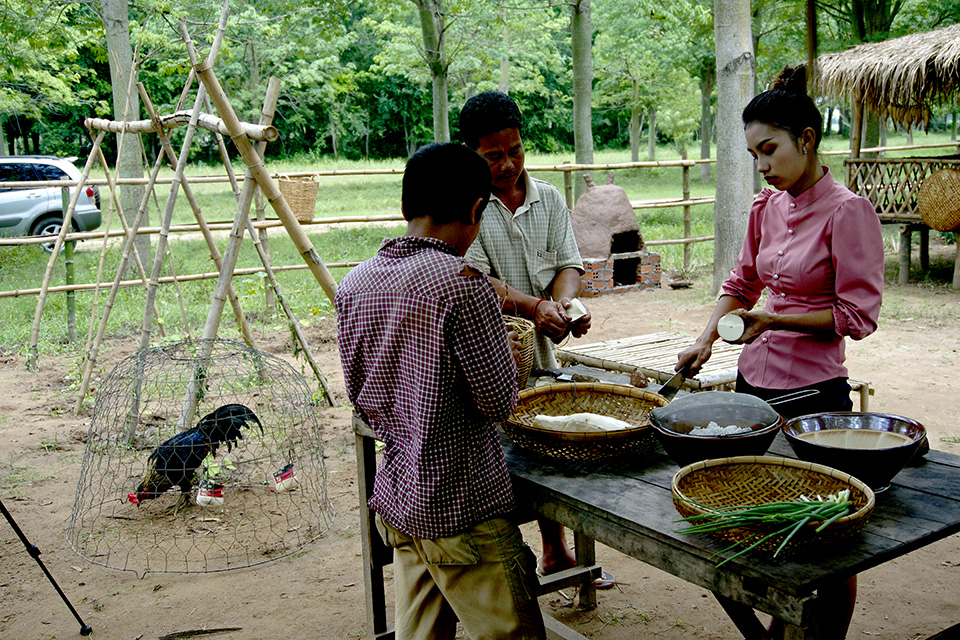PART 2 — On Friday, Coconuts published Part 1 of an exposé investigating a disturbing sub-genre of YouTube videos featuring little boys in Southeast Asia, devouring exotic animals and making animal-like noises, that were getting hundreds of millions of views.
A few days later, roughly 24 hours before the publication of this story, YouTube had taken down the primary channel we identified as being behind the phenomenon, Primitive Technology KH (PTKH), as well as several other related channels we highlighted as featuring similar content, including Primitive Boy and Primitive Wildlife.
On what was formerly the PTKH channel’s page, we now found a takedown notification that read: “This account has been terminated due to multiple or severe violations of YouTube policy against spam, deceptive practices and misleading content or other Terms of Service violations.”

We have reached out to YouTube for comment to find out exactly why they took down the channel and will update this story with their answers, but the timing of the takedown leads us to believe it was in direct response to our article.
PTKH’s channel had been up for well over a year, had videos with hundreds of millions of views, and more than one million subscribers to their channel (the amount required to earn a Youtube Play Button award), which would’ve almost assuredly put the channel on the streaming site’s radar long before.
Prior to YouTube taking down PTKH, we had asked them for information about similar channels, which they declined to give us. But after weeks of research, we finally found evidence that led us to believe we could say with a degree of certainty where the videos were being produced: Cambodia.
A ‘primitive’ studio by the Mekong
We don’t typically cover Cambodia but, considering the unsettling nature of the videos, their massive view counts, and the fact that the phenomenon seemed to be almost entirely unreported, we decided to pursue the story regardless of where it took us.
After running into multiple dead-ends, our Google-fu finally hit upon the clue that would point us in the right direction: a single news story about Cambodian ‘survivalist’ YouTubers who had come under fire for skinning and eating endangered animals that had been picked up by such outlets as British tabloid the Daily Mail.

The May 2018 story concerned a husband and wife team behind a YouTube channel called Natural Life TV (NLTV). The two were briefly arrested after being reported to Cambodia’s Ministry of Environment for allegedly cooking and eating animals on the country’s protected species list. The couple said they had purchased the animals unwittingly at a local market, and after issuing a public apology, the legal issue evaporated.
Our interest in their story, however, was less about their arrests than the simple fact that they were the first actual names we had been able to connect to any primitive technology-themed channels. Remarkably, a reporting contact in Cambodia turned out to have a connection to the pair, who agreed not just to an interview, but to allow us to visit their production facility to watch them film one of the many videos they produce each week.
To be clear, we didn’t harbor the same suspicions about NLTV as we did channels like Primitive Technology KH (PTKH), which feature children devouring exotic animals while making animal-like grunting noises. As it turns out, there are many, many sub-genres of primitive technology-themed videos, with NLTV’s falling on the tamer side of the spectrum.
Unlike the PTKH videos, NTLV’s videos feature adult women who occasionally speak a bit in the Khmer language. While not the most instructive of cooking videos, they don’t feature the same seemingly fetishistic fixation on chewing and consumption. Despite that, NLTV’s videos perform well, with the top video on its channel having earned 18 million views.
We hoped that speaking to the couple would give us some insight into what is a remarkably opaque industry, and perhaps open a path to getting in touch with the people behind PTKH and similar channels.
———–
Our first-hand introduction to the world of primitive tech videos took place on an enormous resin plantation, about two-and-a-half hours outside Phnom Penh.
The set was in the back of an expansive, well-kept property just meters from the shore of the Mekong. There we found a house fashioned from wooden rods with a thatched roof. Inside, it was completely empty – a prop.

There was a small pond and a pen for the ducks, but both were empty as the ducks were being kept at the couple’s real home. Three fighting cocks sat in wooden cages — though it was unclear if they were destined to be part of a production.
Huong Raty, the producer of NLTV, was wearing pressed slacks and a Lacoste shirt when he came out to greet us. The 31-year-old had a gold ring, a nice watch, and carefully styled hair. His wife, Touch Polin, in contrast, arrived wearing traditional Cambodian clothes, her outfit for that day’s shoot.
The video they were shooting during our visit, Cooking Cassava with Coconut Milk in My Village would be uploaded the next day, not to NLTV but to another channel they produce, one called Polin Lifestyle (PL) channel.
The production set-up was simple but professional. Shot on a tripod with an SLR, they worked with the efficiency of a crew that clearly produced these videos on a near-daily basis.
Polin slowly and deliberately cut and stripped a cassava root while being given instructions by her husband off-screen. When the camera stopped filming, she retired to the shade of the house while two men came to the table to quickly slice up what was left.
The full video, which shows Polin arriving on a riverbank in a boat, digging up the cassava roots, then later cooking them with coconut milk, follows the basic tenets of other primitive technology-type videos. There’s no talking, no background music, a lot of long shots, and plenty of repetitive action. There is a calming effect to watching it, much in contrast to the frenzied eating seen in the videos produced by PTKH and similar channels.

Not all of their videos are as innocuous, however. The top videos on their main channel, NLTV, mostly focus on Polin, sometimes accompanied by other women, cooking and eating large game (the videos that allegedly featured protected animals have been deleted from their channel).

When asked about the focus on cooking large animals, Huong, whose own channels used the term “primitive technology” until abruptly dumping it for “Yummy Cooking” about a year ago, told us it was simply a matter of delivering what his audience wants.
“We try to do different types of food every day, but once we saw what people were actually watching, particularly animals cooking, we try to make those more often,” he said. “If the videos focus on desserts or other types of food, not that many people watch.”
Pressed on whether or not he was familiar with the intricacies of YouTube’s algorithm and adjusted his content accordingly, Huong was somewhat dismissive of the role it played in their decision-making.
“We get some promotion from YouTube, but they don’t support us,” he said. “A lot of people on the internet know us now. YouTube recommends the next video or makes suggestions… Good channels don’t need to do anything, because YouTube just knows what is a popular and good video.”

What did seem clear is that NLTV and similar channels first cropped up amid a surge in interest in so-called primitive technology on YouTube. Several articles from 2018 described primitive technology videos as a trend advertisers should know about, and one primitive pool building video even made the platform’s list of top-trending videos for 2018. Piggybacking on that popularity would practically guarantee the platform’s recommendation algorithm would deliver viewers.
Huong’s initial inspiration, however, came not from the original Primitive Technology channel produced by Australian John Plant, but a similar video created by an Indian national he says he’d stumbled across during his search for subject matter.
“From the beginning, I was interested in making videos, because I thought we could earn income by making them and uploading them to YouTube. I didn’t have a topic at first. I did more research and didn’t see anybody in Cambodia doing this,” he said.
Huong said he had never formally studied video production but learned the trade from watching, you guessed it, YouTube videos.
And it certainly seems to have paid off. While initially reluctant to discuss YouTube ad revenue at all, Huong eventually conceded the couple earns “at least US$10,000 per month.”
That number is actually at the low end of what the Social Blade YouTube revenue estimator says the channel could be earning. Based on traffic and other metrics, NLTV could theoretically be pulling in anywhere from $6,900 to $110,000 a month, an enormous sum in a country where the average monthly per capita income is about $114.
Given the large view counts needed to earn that kind of money, it was perhaps unsurprising to find that the biggest consumers of NLTV’s videos don’t actually live in Cambodia, which has fewer than 17 million residents.
“[T]he majority are from India and the United States,” Huong told us. “People from many different countries watch, but those are the main ones. The original plan was not [to shoot] for Cambodian locals, because there would be… higher ad revenue for a foreign audience.”
Unlike the PTKH videos featuring kids, NLTV’s videos still have their comments turned on (remember, YouTube turned off comments on all videos with children back in February after reports they were being systematically targeted by pedophiles), and most of those comments indeed featured a healthy mix of American and Indian commenters.
While Huong insisted he had no knowledge of the people behind the PTKH vids, he didn’t seem particularly fond of their product.
“[They’re] no longer monetized because YouTube is not clear that it’s an interesting topic,” he said dismissively. “It’s quite difficult to monetize videos of kids. In cooking videos, you can advertise for cooking products and restaurants, but there’s no clear topic for them.”
We strongly suspect he is right about kid-centric primitive channels being demonetized ahead of their eventual shuttering by YouTube over the past two days. While PTKH’s last video, Primitive Technology – Eating delicious – Wow Tow boy cooking chinken recipe, was posted five months ago (and earned 2.6 million views) that had been a steep — and rapid — drop-off in the production of primitive-type videos with children over the past few months.
The why, however, would seem to have less to do with interest levels in the content than in the unprecedented number of controversies concerning videos featuring children (see Part 1 for more details).
In June, for example, it was reported that the United State’s Federal Trade Commission was investigating YouTube’s data collection practices and failure to protect children.
While Huong pled ignorance as to the identity or whereabouts of Cambodian producers of kid-centric primitive videos, one thing we know is that YouTube was well aware of their existence.
Huong confirmed that his own channels interact with YouTube representatives, who let them know about changes to monetization policy. NLTV, in fact, has earned an official YouTube Gold Play Button award, given to channels that acquire more than one million subscribers and meet the platform’s Community Standards.
While NLTV hadn’t yet received its physical award, another primitive video YouTuber in Cambodia, the “smart woman” of the Primitive Life Style (PLS) channel, recently already uploaded a video showing off their YouTube Gold Play Button plaque.
https://www.youtube.com/watch?v=s5EMkCMkpEk
Similar to the videos produced by PTKH, the woman in the PLS videos never speaks, instead making animal-like noises, which makes her above acceptance speech, uploaded less than two weeks ago, particularly bizarre. Given the similarities in editing style and tone, it’s entirely possible both channels are produced by the same people.
We should also note that while PTKH stopped uploading 5 months ago, another channel we believe could be connected to them, Primitive Boy, continued to post videos featuring children right up until it was suspended sometime in the past 24 hours. The video below was posted just three days ago.
The Primitive Boy channel appeared to have been demonetized as no advertisements ran on the videos we checked out during our research. But the channel’s owner continued to upload several per week until being deactivated.
————
So what exactly is going on here? Based on everything we’ve learned, here is our best theory.
The original Australian Primitive Technology channel, which premiered in 2015, became massively popular in short order, with spikes in interest peaking between 2016-2017, according to Google Trends.
At some point, producers in Cambodia decided to try their hand at making similar videos and used the term “primitive technology” in their titles to exploit the popularity of the original. Many of the Cambodia-based channels first cropped up in early to mid-2018.
The earliest copycats hewed closer to the Australian version, focusing on construction projects such as pool building. Doubt has been cast on how authentic those videos are, incidentally, with some alleging that they’re deceptively edited to hide the fact that most of the actual building was taking place off-camera using power tools (caution, the video below contains NSFW language).
https://www.youtube.com/watch?v=AEFGfFapZRQ&list=RDAEFGfFapZRQ&start_radio=1&t=10s
But even if they were largely faked, the popular construction videos would still be relatively expensive to produce, even in a country like Cambodia. So producers branched out into other, cheaper-to-produce sub-genres, with videos of animals being hunted, cooked, and eaten proving especially popular — that much more so if it involved children doing the eating.
In addition to the Elsagate videos (discussed in Part 1), there are some striking similarities to other weird YouTube phenomena. One is mukbang, a popular genre of videos originating in South Korea that focus on a person eating massive amounts of food. Mukbang videos are also associated with ASMR, with some people apparently finding the sounds of others loudly chewing and eating pleasurable (a concept we admittedly find difficult to comprehend). There are several primitive-type channels that make videos explicitly targeting ASMR fans (we covered the phenomenon in our latest Coconuts Podcast).
https://www.youtube.com/watch?v=f8HptMzqJXQ
There are also primitive-type videos that make no bones about the fact they are sexualizing their performers. However, many of these actually seem to come from Vietnam.
https://www.youtube.com/watch?v=jBeTjgvbXH4
Judging from their view counts, the sexy-primitive videos featuring bikini-clad hunters aren’t remotely as popular as the primitive eating videos featuring children.
But while profit is the obvious motive for the producers, channels like PTKH would never have been in business if there wasn’t a disturbingly strong demand. So how did they rack up their massive view counts? Who is watching?
We reached out to Taylor Lorenz, a writer for The Atlantic who covers internet culture and who’s become known as one of the foremost experts on weird social media sub-cultures and phenomena.
When we shared the creepy kids vids from Part 1 with Lorenz last week via Twitter DM, she admitted being more than a little flummoxed.
“This is the most bizarre thing I’ve ever heard of. It’s literally so insane,” she wrote back, punctuating her message with a screaming face emoji. “To be totally completely honestly I’m sort of baffled. It’s SO weird!! I can speculate [on] things but honestly I have no idea what this even is. It’s like one of those bizarre corners.”
Baffled or no, Lorenz agreed to further discuss the phenomenon in a phone call from New York in which told us she had never encountered anything like them before and was at a loss to explain how they could have attained their astronomical view counts.
“Like any disturbing, creepy video you find, it’s usually indicative of some terrifying sub-community. And I guess that’s kind of how I feel about these. I don’t know why people are watching these, but I feel like it’s probably for some creepy reason, but I don’t know what it could be,” Lorenz told us.
Lorenz went on to agree that the videos seemed to share certain similarities with the Elsagate videos, which can lead YouTube users down a rabbit hole of similarly-themed content.
“What it reminded me [of] is really creepy auto-generated children’s content where, to a casual viewer, it’s incredibly disturbing and weird and confusing… [while] to somebody who’s just consumed adjacent content, it might not seem that out of the realm,” she said.
Lorenz also saw some similarities with mukbang videos and speculated that the primitive eating videos might hold a certain similar appeal. But she also couldn’t discount the possibility that more sinister motivations could be at play.
“I wouldn’t rule out that there are more nefarious viewers of this content. Obviously, there’s been a lot of media attention around pedophiles who have been engaging in YouTube comments, and so they are definitely a part of the viewership. I don’t think pedophiles are the only ones watching these videos, but I think there might be some other disturbing reasons why people are watching too. I just don’t know.”
To try and understand the psychology of the phenomenon, we also reached out to Frank McAndrew, a professor of psychology at Knox College in the US who specializes in “creepiness” as an area of research. While dismissive of our armchair Freudian theories about the eating vids — namely the possibility of a latent oral fixation — the expert in creepiness still heard more than enough to be sufficiently creeped out.
“The videos certainly sound disturbing, and it sounds as if someone had found a way to give people what they apparently want (which is even more disturbing!),” he wrote to us.
If nothing else, Professor McAndrew’s take was at least helpful in explaining why we, and pretty much everybody we have shown the videos to, are so disturbed by them. His research’s hypothesis is that “… being ‘creeped out’ is an evolved adaptive emotional response to ambiguity about the presence of threat that enables us to maintain vigilance during times of uncertainty.”
In other words, we are creeped out because we can’t be certain who exactly is making them or why. We have no hard evidence that the producers of PTKH or any similar primitive videos are doing anything illegal or abusive, or that their millions of viewers are doing so for nefarious reasons.
Nonetheless, in the case of the videos of young boys cooking and eating animals in the jungle, we can’t help but feel like something was absolutely amiss there. Evidently, Youtube has agreed.
One thing we do know for certain, whether channels like PTKH are gone for good or not, as long as YouTube refuses to disclose information about strange channels that produce content involving children, there is no way anyone but the internet giant can effectively monitor or regulate them. The rest of us will simply be left trying to figure out what the hell is going on.
Additional reporting by Andrew Nachemson.




